Interference is an important property of light. In the given table, Column I shows the properties of interfering waves, Column II shows the phase difference, and Column III shows the path difference between two interfering waves
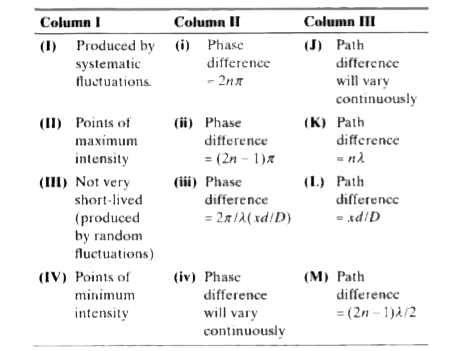
What are the conditions for constructive interference?
(I) (iv) (M)
(IV) (ii) (L)
(II) (i) (K)
(II) (i) (K)
The correct Answer is:D
(II) (i) (K)
Topper's Solved these Questions
- INTERFERENCE AND DIFFRACTION Book:RESNICK AND HALLIDAYChapter:INTERFERENCE AND DIFFRACTION Exercise:PRACTICE QUESTIONS (Integer Type)
Explore 6 Videos
- INTERFERENCE AND DIFFRACTION Book:RESNICK AND HALLIDAYChapter:INTERFERENCE AND DIFFRACTION Exercise:PRACTICE QUESTIONS (Matrix-Match)
Explore 1 Video
- HYDROGEN ATOMBook:RESNICK AND HALLIDAYChapter:HYDROGEN ATOMExercise:PRACTICE QUESTIONS(Integer Type)
Explore 6 Videos
- MAGNETIC FIELDS DUE TO CURRENTSBook:RESNICK AND HALLIDAYChapter:MAGNETIC FIELDS DUE TO CURRENTSExercise:Practice Question (Integer Type)
Explore 4 Videos
Similar Questions
Knowledge Check
Interference is an important property of light. In the given table, Column I shows the properties of interfering waves, Column II shows the phase difference, and Column III shows the path difference between two interfering waves
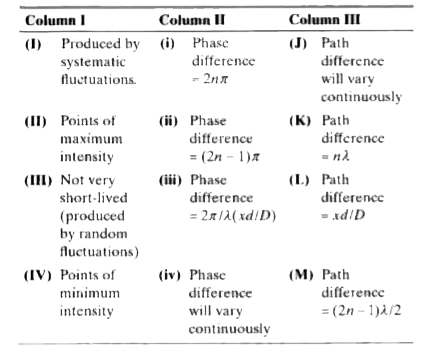
What are the conditions for destructive interference?A(I) (ii) (J)B(IV) (ii) (M)C(II) (iii) (L)D(I) (i) (M)Interference is an important property of light. In the given table, Column I shows the properties of interfering waves, Column II shows the phase difference, and Column III shows the path difference between two interfering waves
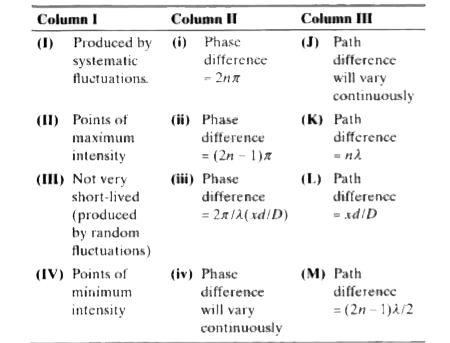
What are the conditions for sustained interference?A(II) (ii) (J)B(III) (iii) (L)C(IV) (i) (L)D(II) (iii) (M)If path difference between two interfering waves is zero, then the point will be
AdarkBbrightCas it isDeither dark of bright
In each equation, there is a table having 3 columns and 4 rows. Based on the table, there are 3 questions. Each question has 4 options (a), (b), (c ) and (d), ONLY ONE of these four options is correct.
There are different types of lasers. In the given table, Colums I shows the properties of different lasers or material used in lasers, Column II shows the different names of the lasers and Column III shows the uses of different type of lasers.
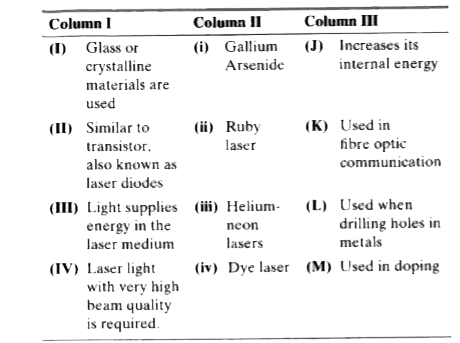
What are the characteristics of solid-state laser?
View SolutionIn each equation, there is a table having 3 columns and 4 rows. Based on the table, there are 3 questions. Each question has 4 options (a), (b), (c ) and (d), ONLY ONE of these four options is correct.
There are different types of lasers. In the given table, Colums I shows the properties of different lasers or material used in lasers, Column II shows the different names of the lasers and Column III shows the uses of different type of lasers.
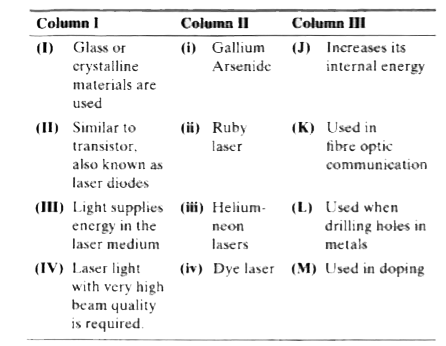
What are the characteristics of semiconductor laser?
View SolutionIn each equation, there is a table having 3 columns and 4 rows. Based on the table, there are 3 questions. Each question has 4 options (a), (b), (c ) and (d), ONLY ONE of these four options is correct.
There are different types of lasers. In the given table, Colums I shows the properties of different lasers or material used in lasers, Column II shows the different names of the lasers and Column III shows the uses of different type of lasers.

What are the characteristics of liquid state laser?
View SolutionThe relationship between phase difference Δϕ and the path difference Δr between two interfering waves is given by: (λ = wavelength)
View Solutionde-Broglie equation gives the relation between particle and wave nature of the matter. In the given table, Column I shows the mass of the matter, Column II shows the speed of the matter and column III shows the kinetic energy of matter.
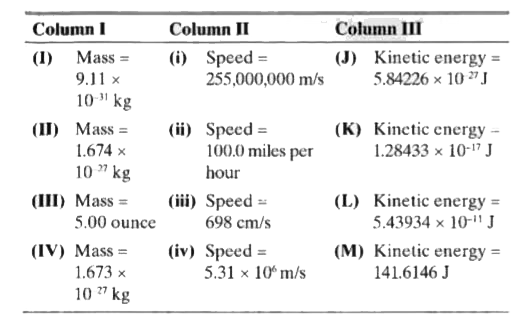
What are the conditions for an electron with a wavelength at 1.37Å?
View Solution

